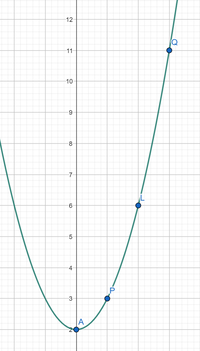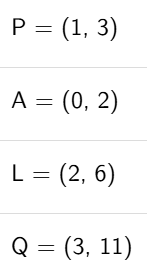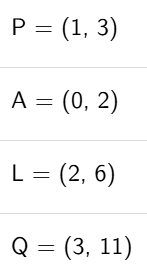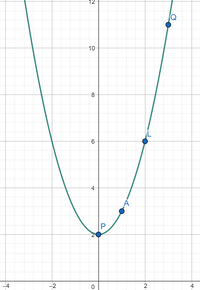Albertopenheimer
silence, truecell speaking
-
- Joined
- Feb 4, 2025
- Posts
- 1,587
HERES HOW TO FIND THE VERTEX OF A PARABOLA WITH ONLY ONE KNOWN VALUE
Heres how:
A vertex in this context is the middle of the spike at the parabola
Introduction:
What values represent what varibles
In some cases theres no p*x, but in those cases its not shown/written because p=0.
I will explain with an example, cuz its the best way to do so.
Example equation:

You also could say

Thats the parabola:

The first number tells the x(left and right) position of it, the second the y(up and down)


With every point the x position gets bigger, so does the y position.
calculate like we dont know the position of point P, A and L. We only know the position of Q
Main part:
[calculating what x and y equals]:
[inserting a slitghtly different value for the x position (Do it with the value of "1" ) compared to the known one, therefore creating a new point]
[checking if he can lie on the parabola; if not do it it in the other direction]
P -> A -> L -> Q
(I fact) The difference between P and A y-value is 1
(II fact) The difference between A and L y-value is 3
(III fact) The difference between L and Q y-value is 5
And as i tried it out with more points, the value difference of the y position keeps increasing by 2
Now:
[get the y-difference between the created point and your start point]
[subtract your y pos every time; but every time u do it subtract by a 2 values lower number (only all the times after the first time of subracting)]
[dont keep subtracting if you just subtracted by 1]
>now u know the y pos of the parabola
[insert it into f(x) and get x to know]
>know u know the vertex of the parabola
Heres how:
A vertex in this context is the middle of the spike at the parabola
Introduction:
What values represent what varibles
|
|
I will explain with an example, cuz its the best way to do so.
Example equation:
You also could say
Thats the parabola:
The first number tells the x(left and right) position of it, the second the y(up and down)
With every point the x position gets bigger, so does the y position.
calculate like we dont know the position of point P, A and L. We only know the position of Q
Main part:
[calculating what x and y equals]:
[inserting a slitghtly different value for the x position (Do it with the value of "1" ) compared to the known one, therefore creating a new point]
[checking if he can lie on the parabola; if not do it it in the other direction]
P -> A -> L -> Q
(I fact) The difference between P and A y-value is 1
(II fact) The difference between A and L y-value is 3
(III fact) The difference between L and Q y-value is 5
And as i tried it out with more points, the value difference of the y position keeps increasing by 2
Now:
[get the y-difference between the created point and your start point]
[subtract your y pos every time; but every time u do it subtract by a 2 values lower number (only all the times after the first time of subracting)]
[dont keep subtracting if you just subtracted by 1]
>now u know the y pos of the parabola
[insert it into f(x) and get x to know]
>know u know the vertex of the parabola
Attachments
Last edited:









